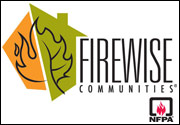 Firewise
Firewise
A Program to Protect Your Home
Fire is a natural part of our environment. Yet with more people living in rural areas there is a greater chance of wildfires causing loss of life, property and damage to natural resources. Protecting everyone’s property presents a challenge when trying to control wildfires. Homes close to evergreens and tall prairie or marsh grasses are most at risk. Protecting homes from an approaching wildfire is the goal of the Firewise program.
To discover more about fire prevention and the Firewise Program call us today.
Is Your Home Firewise?
As a homeowner, you must realize that the threat of wildfire is real. Minnesota experiences more than 2,000 wildfires a year. While fire is an inherent danger when living in a home in the woods, there are ways to help minimize the risks and to protect your property and your home from the ravages of wildfire.
Creating a defensible space around your house can enable your home to survive a wildfire. This defensible space is an area of reduced vegetation (fuels) between your home and the forest.
Creating a Defensible Space Zone
The National Fire Protection Association’s Firewise Communities Program has developed guidelines to help save lives and property from wildfire.
Step 1: Assess Your Property
- Do you border wildland?
- Is there a substantial amount of tall vegetation growing around your home?
- Do tree limbs extend over your home?
- Do you have a woodpile near to your home?
- Do you have any fuel tanks nearby?
- Does your property's driveway provide easy access to your home for firefighters?
Step 2: Take Action!
- Thin tree and brush cover around your home.
- Dispose of slash and debris from thinning.
- Remove dead limbs, leaves and other litter.
- Stack firewood away from your home.
- Maintain an irrigated greenbelt.
- Mow dry grasses.
- Prune bottom branches to 10 feet above the ground.
- Trim other branches as necessary.
- Clean your roof and gutters.
- Make sure your driveway has not been overtaken with vegetation. Emergency vehicles need a 12-foot-wide clearance and adequate space to turn
around.
Every year, Minnesota wildland firefighters and local fire departments respond to wildfires that are a result of careless human actions. Debris burning causes about 40 percent of Minnesota’s wildfires. Burning household waste has been illegal on Leech Lake Reservation since 2006.
Permits are required for all fires. Most burning permits have an approved time frame (usually from 6 p.m. to 8 a.m.) and require the fire to be attended at all times.
![]()
Source: The National Fire Protection Association
(218) 335-7439 Phone
800-442-3942 Toll-free
(218) 335-7404 Fax
National Fire Protection Association at: www.firewise.org















 Division of Resource Management
Division of Resource Management